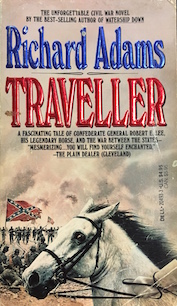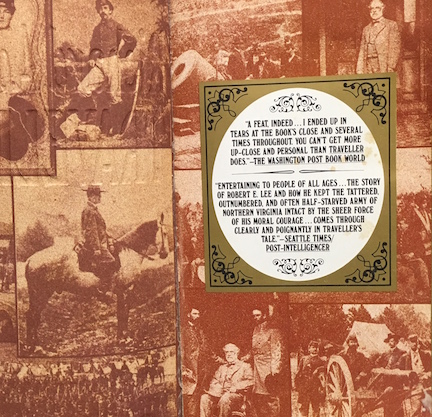Richard Adams, Author of Traveller, dies at 96
 While most of the pop culture world was mourning the death this week of Star Wars’ Princess Leia and 80s pop icon George Michael, I heard the quieter news of the death of one of my favorite authors, Richard Adams. Best known for his novel Watership Down, Adams also authored a book known to many fans of Civil War-related literature, Traveller (1988), which tells the tale of Robert E. Lee’s famous gray horse.
While most of the pop culture world was mourning the death this week of Star Wars’ Princess Leia and 80s pop icon George Michael, I heard the quieter news of the death of one of my favorite authors, Richard Adams. Best known for his novel Watership Down, Adams also authored a book known to many fans of Civil War-related literature, Traveller (1988), which tells the tale of Robert E. Lee’s famous gray horse.
Starting in the spring of 1866, Traveller is stabled on the campus of Washington College (now Washington & Lee University), where he enjoys a quiet retirement while “Marse Robert” serves as president of the college. In memoir-like fashion, the horse tells his life story to a pair of cats, Nippy and Baxter, owned by one of Lee’s daughters, Mildred. Written in a kind of Southern dialect—by an Englishman, no less—the book is sometimes tricky to read, but it’s a pleasant and creative tale. Kirkus Reviews called it an “inventive and affecting blend of historical chronicle and animal fable that gallops right into the heart of beast, man, and war.”
 To research his novel, Adams relied heavily on sources well known to most Civil War buffs: Recollections and Letters of General Robert E. Lee; General Lee, 1861-1865 by Walter Taylor; Memoirs of Robert E. Lee: His Military and Personal History by A. L. Long; and Personal Reminiscences by J. William Jones. He also leaned on Douglas Southall Freeman’s R. E. Lee—which he “most enjoyed”—and Charles Bracelen Flood’s Lee: The Last Years.
To research his novel, Adams relied heavily on sources well known to most Civil War buffs: Recollections and Letters of General Robert E. Lee; General Lee, 1861-1865 by Walter Taylor; Memoirs of Robert E. Lee: His Military and Personal History by A. L. Long; and Personal Reminiscences by J. William Jones. He also leaned on Douglas Southall Freeman’s R. E. Lee—which he “most enjoyed”—and Charles Bracelen Flood’s Lee: The Last Years.
“Anecdotes of Lee and Traveller are, of course, innumerable,” Adams wrote in the author’s note of his book.
To get inside Traveller’s head, so to speak, he drew on the research of Lucy Rees’s The Horse’s Mind.
Unfortunately, Traveller remains the only one of Adams’s major novels that’s gone out of print. Paperback and ebook versions are available for his other major books, Watership Down (1972), Shardik (1974), The Plague Dogs (1977), and Tales from Watership Down (1996), with nearly a dozen other minor works also published during that time through 2010.

Like most of his fans, I came to his work through Watership Down, a tale about a group of wild rabbits driven from their home. The book follows their quest to establish a new home. He invented the story for his daughters, told to them just before bedtime. Eventually, they persuaded him to write the stories into book form. Six publishers rejected the manuscript before it was finally picked up—and then it became a worldwide phenomenon. Although originally a children’s take, he claimed it was appropriate for kids from nine to ninety—an assessment millions of adults would agree with.
So, I first came to Traveller in the late 80s as a Richard Adams fan, not as Civil War buff. I read the novel as a fan of good writing and interesting stories, not as someone interested in history or Civil War-related literature. I’ve carted that paperback with me through college and three subsequent graduate degrees, two children, eight relocations, and into a second marriage. The book is, as you might image, a little worn on the cover with small flecks and nicks, and a pair of waterstains blossom across the closed page edges.
To be honest, it’s been so long since I’ve read the book that I can’t even tell you how accurate or inaccurate its historical elements are. One look at his list of sources reminds me what a Confederate-centric book it is—but then again, it’s told from the adoring and loyal perspective of Lee’s horse, so it wasn’t really supposed to be nonpartisan to begin with.
What I do remember about the book is a larger lesson that Adams himself embodied, too. He was not afraid, as a writer, to take a risk with his work. He committed himself to a tale and stayed as absolutely true to it as he could, which in turn gave it life, depth, context, and resonance. Traveller rings true, not because the history is true or its historical interpretation is true but because Traveller’s perspective and voice are absolutely, 100% true to what they should be. That’s the only way to make a story like that—or a story about nomadic rabbits—at all believable enough to read, let alone sustain over the length of a novel.
Richard Adams died at 10 p.m. on Christmas Eve at the age of 96.
I did not realize the Richard Adams of Watership Down fame had written this book. As you say, it can be a difficult read, but it’s uniqueness makes it memorable.
“Paperback and ebook versions are available for his other major books”
It appears to be available on the Kindle.
I read this book years ago and found it to be a page turner. But, recently, in trying to clear some space on the ol’ bookshelf I decided to retire “Traveller” and relegated him to the box for sale, gifting or trade. But, when I read this I scurried to the box and put it back on the shelf. Seems sacrilegious to part with it now; a truly creative work. Rest in peace Mr. Adams!
I’ll have to find a copy. It sounds like interesting fiction reading.
Sarah Key – I’d be happy to gift it to you if you like. All I need is a mailing address which you can send, if you want, separately to dfishel@comcast.net.
Thanks, Dale. I just sent you an email.
I ordered a used one from amazonsmile–it may pick up in sales just from ECW readers. My first literary endeavor was an examination of Paul revere’s ride from the point of view of his horse. I think Longfellow was about my only reference–that and maybe a school text. Geez!
I simply LOVED reading ‘Traveller’ and have never forgotten it. Richard Adams had a remarkable facility for drawing his readers into the world of the animals he was writing about.
I have fond but hazy memories of “Traveller.” Knowing I was a Civil War buff, my grandmother lent it to me when I was 8 or 9. If it seems a difficult read as an adult, imagine a young kid trying to wade through it. But I did, and it was the first grown-up novel I finished. Making the famous horse an adoring, tale-telling animal with a southern speech pattern was ingenious on Adams’s part.